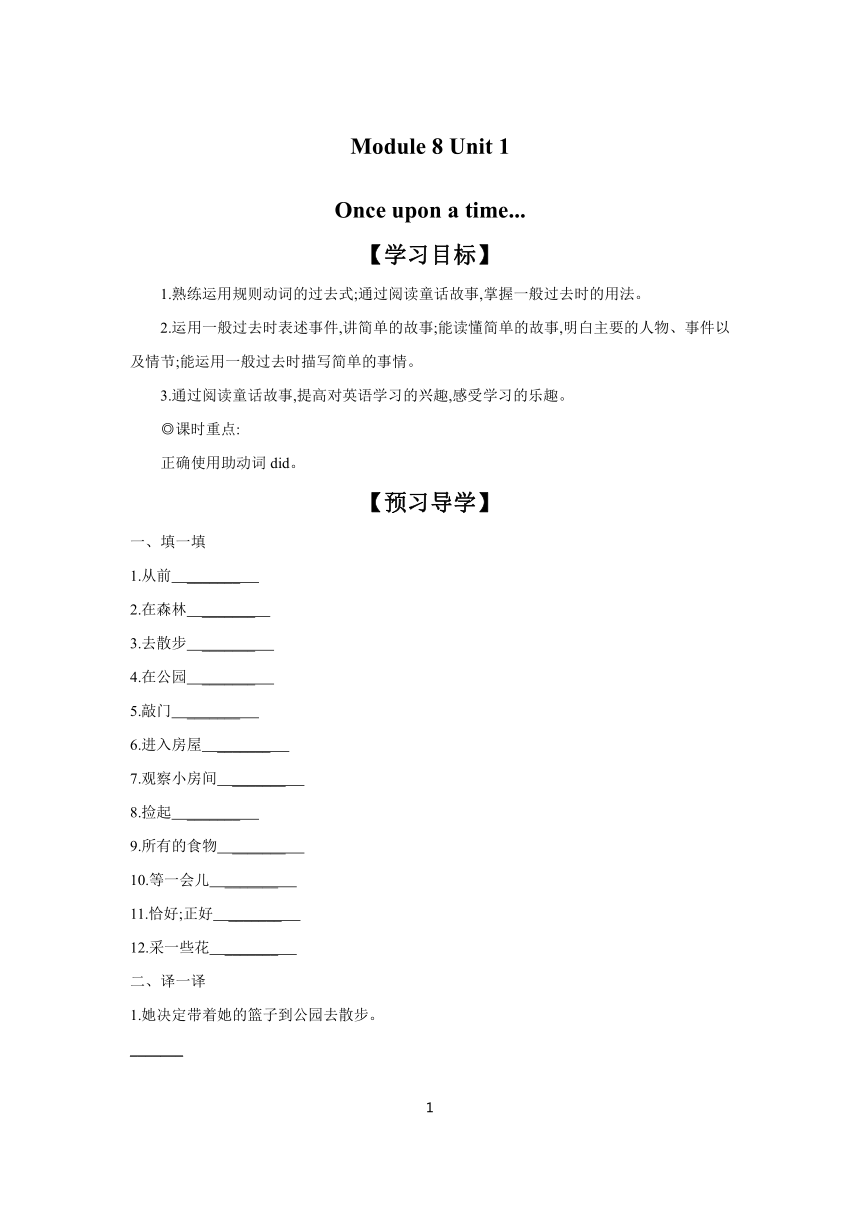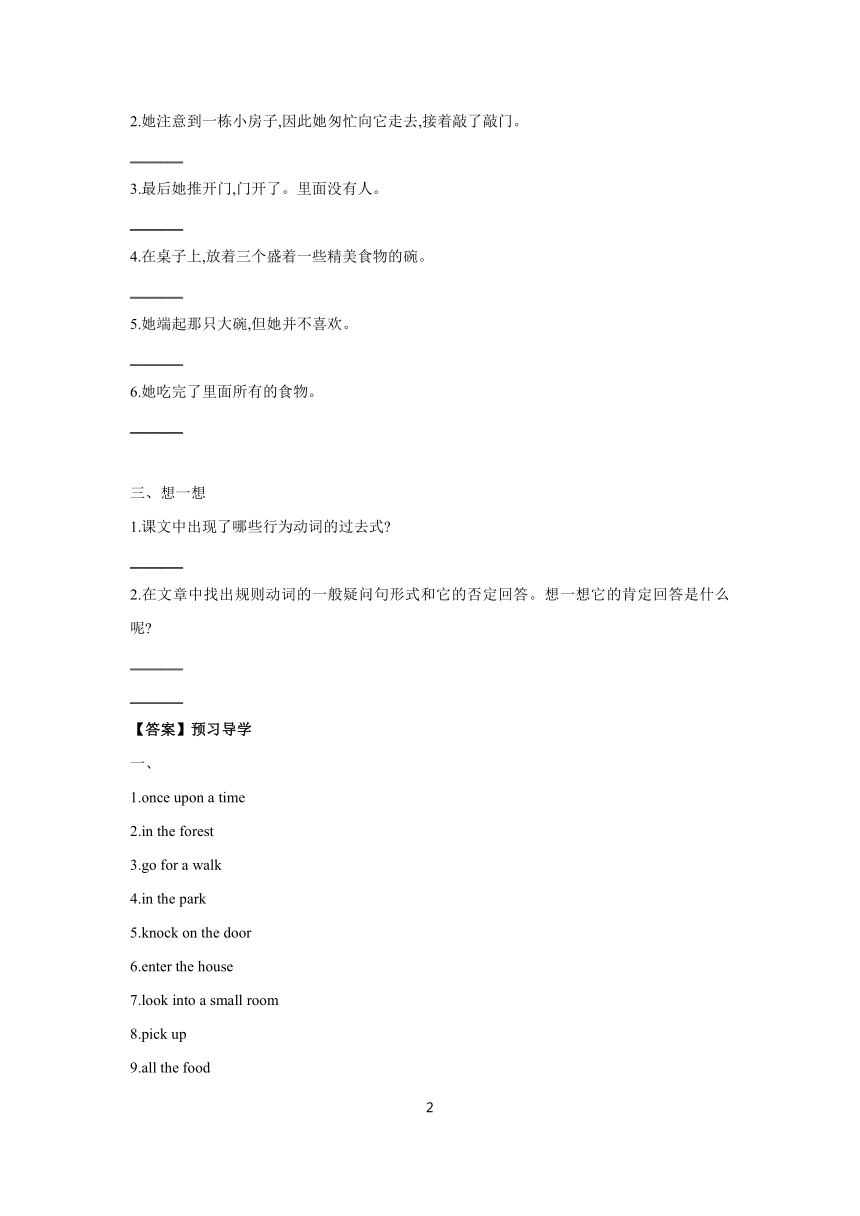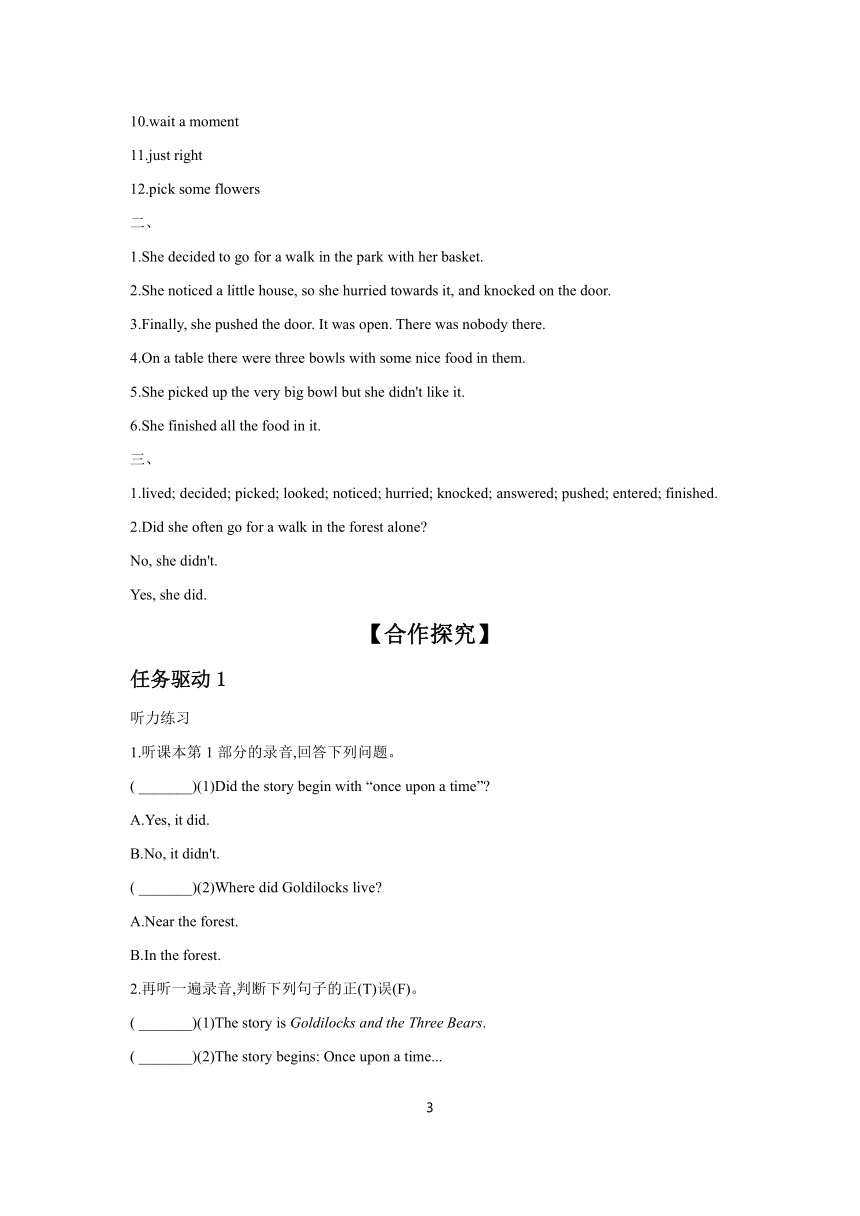Module 8 Story time Unit 1 学案 2023-2024学年初中英语外研版七年级下册(含答案)
文档属性
| 名称 | Module 8 Story time Unit 1 学案 2023-2024学年初中英语外研版七年级下册(含答案) |

|
|
| 格式 | docx | ||
| 文件大小 | 25.4KB | ||
| 资源类型 | 教案 | ||
| 版本资源 | 外研版 | ||
| 科目 | 英语 | ||
| 更新时间 | 2024-02-20 22:43:53 | ||
图片预览



文档简介
Module 8 Unit 1
Once upon a time...
【学习目标】
1.熟练运用规则动词的过去式;通过阅读童话故事,掌握一般过去时的用法。
2.运用一般过去时表述事件,讲简单的故事;能读懂简单的故事,明白主要的人物、事件以及情节;能运用一般过去时描写简单的事情。
3.通过阅读童话故事,提高对英语学习的兴趣,感受学习的乐趣。
◎课时重点:
正确使用助动词did。
【预习导学】
一、填一填
1.从前 _______
2.在森林 _______
3.去散步 _______
4.在公园 _______
5.敲门 _______
6.进入房屋 _______
7.观察小房间 _______
8.捡起 _______
9.所有的食物 _______
10.等一会儿 _______
11.恰好;正好 _______
12.采一些花 _______
二、译一译
1.她决定带着她的篮子到公园去散步。
_______
2.她注意到一栋小房子,因此她匆忙向它走去,接着敲了敲门。
_______
3.最后她推开门,门开了。里面没有人。
_______
4.在桌子上,放着三个盛着一些精美食物的碗。
_______
5.她端起那只大碗,但她并不喜欢。
_______
6.她吃完了里面所有的食物。
_______
三、想一想
1.课文中出现了哪些行为动词的过去式
_______
2.在文章中找出规则动词的一般疑问句形式和它的否定回答。想一想它的肯定回答是什么呢
_______
_______
【答案】预习导学
一、
1.once upon a time
2.in the forest
3.go for a walk
4.in the park
5.knock on the door
6.enter the house
7.look into a small room
8.pick up
9.all the food
10.wait a moment
11.just right
12.pick some flowers
二、
1.She decided to go for a walk in the park with her basket.
2.She noticed a little house, so she hurried towards it, and knocked on the door.
3.Finally, she pushed the door. It was open. There was nobody there.
4.On a table there were three bowls with some nice food in them.
5.She picked up the very big bowl but she didn't like it.
6.She finished all the food in it.
三、
1.lived; decided; picked; looked; noticed; hurried; knocked; answered; pushed; entered; finished.
2.Did she often go for a walk in the forest alone
No, she didn't.
Yes, she did.
【合作探究】
任务驱动1
听力练习
1.听课本第1部分的录音,回答下列问题。
( _______)(1)Did the story begin with “once upon a time”
A.Yes, it did.
B.No, it didn't.
( _______)(2)Where did Goldilocks live
A.Near the forest.
B.In the forest.
2.再听一遍录音,判断下列句子的正(T)误(F)。
( _______)(1)The story is Goldilocks and the Three Bears.
( _______)(2)The story begins: Once upon a time...
( _______)(3)Goldilocks was a girl with hair of gold.
( _______)(4)Goldilocks lived in the forest.
( _______)(5)She decided to go for a walk in the park with her basket.
任务驱动2 时态练习
1.从课本中找出下列动词的过去式。
(1)walk _______
(2)pick _______
(3)look _______
(4)notice _______
(5)hurry _______
(6)knock _______
(7)answer _______
(8)push _______
(9)ask _______
(10)stop _______
(11)enter _______
(12)live _______
(13)finish _______
(14)am/is _______
(15)do _______
2.你能通过上面的练习,总结出动词变过去式的规律吗
_______
_______
【答案】合作探究
任务驱动一 听力练习
1.(1)A (2)A
2.(1)T (2)T (3)T (4)F (5)F
任务驱动二 时态练习
1.(1)walked (2)picked (3)looked (4)noticed (5)hurried (6)knocked (7)answered (8)pushed
(9)asked (10)stopped (11)entered (12)lived (13)finished (14)was (15)did
2.(1)一般情况下,在行为动词的末尾,直接加-ed。
(2)以不发音的字母e结尾的单词,在单词后面直接加-d。
(3)以辅音字母加y结尾的单词,变y 为i,加-ed。
(4)以重读闭音节结尾,末尾只有一个辅音字母的单词,变过去式时先双写这个辅音字母,再加-ed。
【知识超市】
●行为动词的一般过去式
一般过去时表示过去某个时间发生的动作或存在的状态,常和表示过去的时间状语连用,如last year、 yesterday等;也可表示过去经常反复发生的动作,常和often、 always等频率副词连用。例如:
I saw him in the street yesterday. 我昨天在街上看到了他。
1.一般过去时的形式
be动词: 第一人称单数和第三人称单数用was, 其余的人称一律用were。
行为动词:一律用过去式,没有人称和数的变化。
行为动词的过去式有两类:一类是规则动词,另一类是不规则动词。
行为动词的过去式的否定式,要使用助动词 do 的过去式did,后面的谓语动词要还原为原形。
2.一般过去时的几种句型(这里只讲行为动词)
肯定句结构:主语+动词的过去式+其他.例如:
He went to the toy store yesterday. 他昨天去了玩具店。
否定句结构:主语+did not (didn't)+动词原形+其他.例如:
He didn't go to the toy store yesterday.他昨天没去玩具店。
一般疑问句的构成:Did+主语+动词原形+其他
特殊疑问句的构成:疑问词+did+主语+动词原形+其他
3.一般过去时口诀
一般过去时并不难,表示过去动作、状态记心间。 动词要用过去式,时间状语句末站。
否定句很简单,didn't 站在动词原形前,其他部分不要变。
一般疑问句也好变,did放在句子前,主语、动词原形、其他部分依次站。
特殊疑问句也简单,疑问词加一般疑问句记心间。
做一做:单项选择。
( _______)1.What they dinner yesterday
A.do; have for B.did; had for
C.did; have for D.were; have for
( _______)2.Can you tell me what time the plane
A.to leave B.leaves
C.leave D.was leaving
( _______)3.One of us the band last month.
A.leaves B.leave
C.leaved D.left
( _______)4.I got up this morning, so I breakfast and went to school.
A.late; didn't have
B.early; didn't have
B.late; hadn't
D.early; hadn't
( _______)5.It much cold today than it yesterday.
A.is; is B.was; was
C.is; was D.was; is
( _______)6.He didn't come goodbye to us and away.
A.say; go B.say; went
C.to say; went D.to say; go
【答案】
知识超市
做一做:
1.C 2.B 3.D 4.A 5.C 6.C
2
Once upon a time...
【学习目标】
1.熟练运用规则动词的过去式;通过阅读童话故事,掌握一般过去时的用法。
2.运用一般过去时表述事件,讲简单的故事;能读懂简单的故事,明白主要的人物、事件以及情节;能运用一般过去时描写简单的事情。
3.通过阅读童话故事,提高对英语学习的兴趣,感受学习的乐趣。
◎课时重点:
正确使用助动词did。
【预习导学】
一、填一填
1.从前 _______
2.在森林 _______
3.去散步 _______
4.在公园 _______
5.敲门 _______
6.进入房屋 _______
7.观察小房间 _______
8.捡起 _______
9.所有的食物 _______
10.等一会儿 _______
11.恰好;正好 _______
12.采一些花 _______
二、译一译
1.她决定带着她的篮子到公园去散步。
_______
2.她注意到一栋小房子,因此她匆忙向它走去,接着敲了敲门。
_______
3.最后她推开门,门开了。里面没有人。
_______
4.在桌子上,放着三个盛着一些精美食物的碗。
_______
5.她端起那只大碗,但她并不喜欢。
_______
6.她吃完了里面所有的食物。
_______
三、想一想
1.课文中出现了哪些行为动词的过去式
_______
2.在文章中找出规则动词的一般疑问句形式和它的否定回答。想一想它的肯定回答是什么呢
_______
_______
【答案】预习导学
一、
1.once upon a time
2.in the forest
3.go for a walk
4.in the park
5.knock on the door
6.enter the house
7.look into a small room
8.pick up
9.all the food
10.wait a moment
11.just right
12.pick some flowers
二、
1.She decided to go for a walk in the park with her basket.
2.She noticed a little house, so she hurried towards it, and knocked on the door.
3.Finally, she pushed the door. It was open. There was nobody there.
4.On a table there were three bowls with some nice food in them.
5.She picked up the very big bowl but she didn't like it.
6.She finished all the food in it.
三、
1.lived; decided; picked; looked; noticed; hurried; knocked; answered; pushed; entered; finished.
2.Did she often go for a walk in the forest alone
No, she didn't.
Yes, she did.
【合作探究】
任务驱动1
听力练习
1.听课本第1部分的录音,回答下列问题。
( _______)(1)Did the story begin with “once upon a time”
A.Yes, it did.
B.No, it didn't.
( _______)(2)Where did Goldilocks live
A.Near the forest.
B.In the forest.
2.再听一遍录音,判断下列句子的正(T)误(F)。
( _______)(1)The story is Goldilocks and the Three Bears.
( _______)(2)The story begins: Once upon a time...
( _______)(3)Goldilocks was a girl with hair of gold.
( _______)(4)Goldilocks lived in the forest.
( _______)(5)She decided to go for a walk in the park with her basket.
任务驱动2 时态练习
1.从课本中找出下列动词的过去式。
(1)walk _______
(2)pick _______
(3)look _______
(4)notice _______
(5)hurry _______
(6)knock _______
(7)answer _______
(8)push _______
(9)ask _______
(10)stop _______
(11)enter _______
(12)live _______
(13)finish _______
(14)am/is _______
(15)do _______
2.你能通过上面的练习,总结出动词变过去式的规律吗
_______
_______
【答案】合作探究
任务驱动一 听力练习
1.(1)A (2)A
2.(1)T (2)T (3)T (4)F (5)F
任务驱动二 时态练习
1.(1)walked (2)picked (3)looked (4)noticed (5)hurried (6)knocked (7)answered (8)pushed
(9)asked (10)stopped (11)entered (12)lived (13)finished (14)was (15)did
2.(1)一般情况下,在行为动词的末尾,直接加-ed。
(2)以不发音的字母e结尾的单词,在单词后面直接加-d。
(3)以辅音字母加y结尾的单词,变y 为i,加-ed。
(4)以重读闭音节结尾,末尾只有一个辅音字母的单词,变过去式时先双写这个辅音字母,再加-ed。
【知识超市】
●行为动词的一般过去式
一般过去时表示过去某个时间发生的动作或存在的状态,常和表示过去的时间状语连用,如last year、 yesterday等;也可表示过去经常反复发生的动作,常和often、 always等频率副词连用。例如:
I saw him in the street yesterday. 我昨天在街上看到了他。
1.一般过去时的形式
be动词: 第一人称单数和第三人称单数用was, 其余的人称一律用were。
行为动词:一律用过去式,没有人称和数的变化。
行为动词的过去式有两类:一类是规则动词,另一类是不规则动词。
行为动词的过去式的否定式,要使用助动词 do 的过去式did,后面的谓语动词要还原为原形。
2.一般过去时的几种句型(这里只讲行为动词)
肯定句结构:主语+动词的过去式+其他.例如:
He went to the toy store yesterday. 他昨天去了玩具店。
否定句结构:主语+did not (didn't)+动词原形+其他.例如:
He didn't go to the toy store yesterday.他昨天没去玩具店。
一般疑问句的构成:Did+主语+动词原形+其他
特殊疑问句的构成:疑问词+did+主语+动词原形+其他
3.一般过去时口诀
一般过去时并不难,表示过去动作、状态记心间。 动词要用过去式,时间状语句末站。
否定句很简单,didn't 站在动词原形前,其他部分不要变。
一般疑问句也好变,did放在句子前,主语、动词原形、其他部分依次站。
特殊疑问句也简单,疑问词加一般疑问句记心间。
做一做:单项选择。
( _______)1.What they dinner yesterday
A.do; have for B.did; had for
C.did; have for D.were; have for
( _______)2.Can you tell me what time the plane
A.to leave B.leaves
C.leave D.was leaving
( _______)3.One of us the band last month.
A.leaves B.leave
C.leaved D.left
( _______)4.I got up this morning, so I breakfast and went to school.
A.late; didn't have
B.early; didn't have
B.late; hadn't
D.early; hadn't
( _______)5.It much cold today than it yesterday.
A.is; is B.was; was
C.is; was D.was; is
( _______)6.He didn't come goodbye to us and away.
A.say; go B.say; went
C.to say; went D.to say; go
【答案】
知识超市
做一做:
1.C 2.B 3.D 4.A 5.C 6.C
2
同课章节目录
- Module 1 Lost and found
- Unit 1 Whose bag is this?
- Unit 2 Are they yours?
- Unit 3 Language in use
- Module 2 What can you do ?
- Unit 1 I can play the piano
- Unit 2 I can run really fast
- Unit 3 Language in use
- Module 3 Making plans
- Unit 1 What are you going to do at the weekends?
- Unit 2 We're going to cheer the players.
- Unit 3 Language in use
- Module 4 Life in the future
- Unit 1 Everyone will study at home
- Unit 2 Every family will have a small plane.
- Unit 3 Language in use
- Module 5 Shopping
- Unit 1 What can I do for you?
- Unit 2 You can buy everything on the Internet
- Unit 3 Language in use
- Module 6 Around town
- Unit 1 Could you tell me how to get to the Nationa
- Unit 2 The London Eye is on your right.
- Unit 3 Language in use
- Revision module A
- Module 7 My past life
- Unit 1 I was born in a small village.
- Unit 2 I was born in Quincy.
- Unit 3 Language in use
- Module 8 Story time
- Unit 1 Once upon a time….
- Unit 2 Goldilocks hurried out of the house.
- Unit 3 Language in use
- Module 9 Life history
- Unit 1 He left school and began work at the age of
- Unit 2 He decided to be an actor.
- Unit 3 Language in use
- Module 10 A holiday journey
- Unit 1 What did you do?
- Unit 2 This morning we took a walk.
- Unit 3 Language in use
- Module 11 Body language
- Unit 1 They touch noses!
- Unit 2 Here are some ways to welcome them.
- Unit 3 Language in use
- Module 12 Western music
- Unit 1 It's so beautiful!
- Unit 2 Vienna is the centre of European classical
- Unit 3 Language in use
- Revision module B
